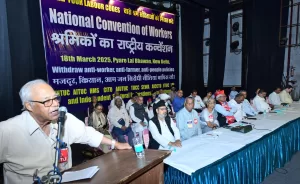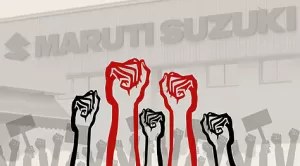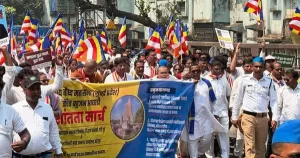Why Do Soldiers Continue to Die on the India-Pakistan Border?

In 1947 India was divided by the foreign rulers by playing a game of divide and rule to which the religious fundamentalists fell prey. Since then, India and Pakistan have had a checkered history and uneasy relationship, sometimes climaxing in violent conflagrations and war.
While both the governments prefer to maintain an adversarial relationship, which now sustains vested interests on both sides, the common people and business interests on both the sides want peace. They do not want conflicts in which people die. The soldiers dying on both sides, after all, come from mostly modest middle class rural backgrounds. While the leaders can meet when they choose to, the common people do not have control over their destiny. The Indian Prime Minister Narendra Modi stopped over in Pakistan in December 2015 while on the way from Afghanistan and participated in a family event of Pakistani PM Nawaz Sharif; the former heads of intelligence agencies of both countries, Asad Durrani of the Inter-Services Intelligence of Pakistan and Amarjit Singh Dulat of Research and Analysis Wing of India, co-authored a book The Spy Chronicles: RAW, ISI and the Illusion of Peace; the National Security Advisors of the two countries, retired Lt. Gen. Nasser Khan Janjua and Ajit Doval, continue to meet in third countries; Adani is interested in selling 4,000 MW of power to Pakistan; and powerful business interests have ensured a peaceful border in Gujarat. Why then do soldiers keep killing each other on the northern border? We never hear of any Indian soldiers dying on the Indo-China border, probably because India and China have an unwritten / unspoken agreement not to kill each otheru2019s soldiers. If this is so, why canu2019t a similar understanding be reached with Pakistan. After all, leaders of governments and intelligence agencies and security advisors are talking to each other.
We believe that if the governments of India and Pakistan cannot solve the disputes between the two countries, then the people should take the initiative. If the common people of the two countries are allowed to meet, then over a period of time peace and harmony will prevail. The two governments should facilitate the meeting of common people from the two sides by granting them passports and visas easily. Since people from the two sides of the border share a common culture, they can play an important role where the governments have failed.
Along the Indian border with Pakistan, there are openings between Srinagar and Muzaffarabad in Kashmir, at Wagahu2013Attari in Punjab and at Munabaou2013Khokrapar in Rajasthanu2013Sindh. Gujarat doesnu2019t have an opening into Pakistan even though a number of fisherfolk from both sides land up in each otheru2019s jails. The people in Bhuj, Kutch have had intimate relationships with people from the other side, and given an opportunity, trade can flourish between the two areas again.
If the border between Gujarat and Sindh is opened either at Khavda or Nada Bet, the people from the two sides will get an opportunity to meet easily, there will be promotion of trade and tourism, and ultimately peace and friendship will be strengthened. The fisherfolk whose relatives land in jail on other side can easily travel across the border to find out about their well being and make an effort to get them released. It is in the interest of common people that borders are opened up.
If people of the two countries are allowed to meet freely, an atmosphere of peace and harmony will be created in which it will be easier to resolve the outstanding disputes too. When our defence expenses will go down, resources will be freed up for developmental activities which will benefit the poor on both sides.
When the two Koreas can end their enmity after almost as long a period as Indiau2013Pakistan animosity has existed, why canu2019t the two South Asian neighbours not achieve the same feat?
The two governments should also take an initiative to replace the military ceremony on Wagahu2013Attari every evening with a peace ceremony where people are allowed to meet and celebrate peace, harmony, friendship and their shared culture. Such a model of peace ceremony can then be replicated on all border openings. A model for peace ceremony has been developed by a class on Social Movements at the Indian Institute of Technology, Gandhinagar during 2016u201317.
The governments of India and Pakistan should create a situation in which ultimately all restrictions on travel across the border are removed and people are allowed to meet freely. This will be a great service to humanity.
An Indiau2013Pakistan Friendship and Peace March is being organised from 19 to 30 June, 2018 from Sabarmati Ashram, Ahmedabad to Nada Bet on Pakistan border, 290 km from Ahmedabad. Organisations endorsing this March include Pakistan India Peopleu2019s Forum for Peace and Democracy, Aaghaz-e-Dosti, Minority Coordination Committee, Gujarat, Gujarat Lok Samiti, Bandhkam Mazdoor Sangathan, Pakistan Institute for Labour Education and Research, Karachi, National Alliance of Peopleu2019s Movements, u00a0Bombay Sarvodaya Mandal, All India Secular Forum, Manthan Samayiki, Kolkata, Jharkhand Nagrik Prayas, sacw.net, Confederation of Voluntary Agencies, Hyderabad, Hamari Awaz, Insaf Foundation, Gujarat Mazdoor Panchayat, Khudai Khidmatgar and Socialist Party (India).
When European countries, which were such bitter enemies of each other that they converted their wars into World Wars less than a hundred years ago, can create a Union in which all restrictions on travel have been removed, why canu2019t the same thing be achieved in South Asia? If over a hundred countries in five regions of the world can sign on agreements to make themselves Nuclear Weapon Free Zones, why canu2019t India and Pakistan do the same? In the long term, there is no alternative to the low intensity war currently being waged between the two countries other than to establish peace and friendship, especially since a full-fledged war in not possible because of the presence of nuclear weapons on both sides.










